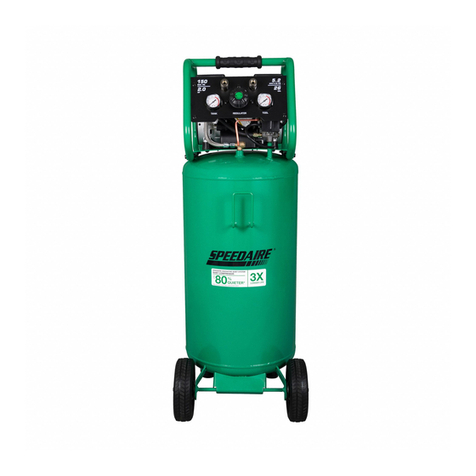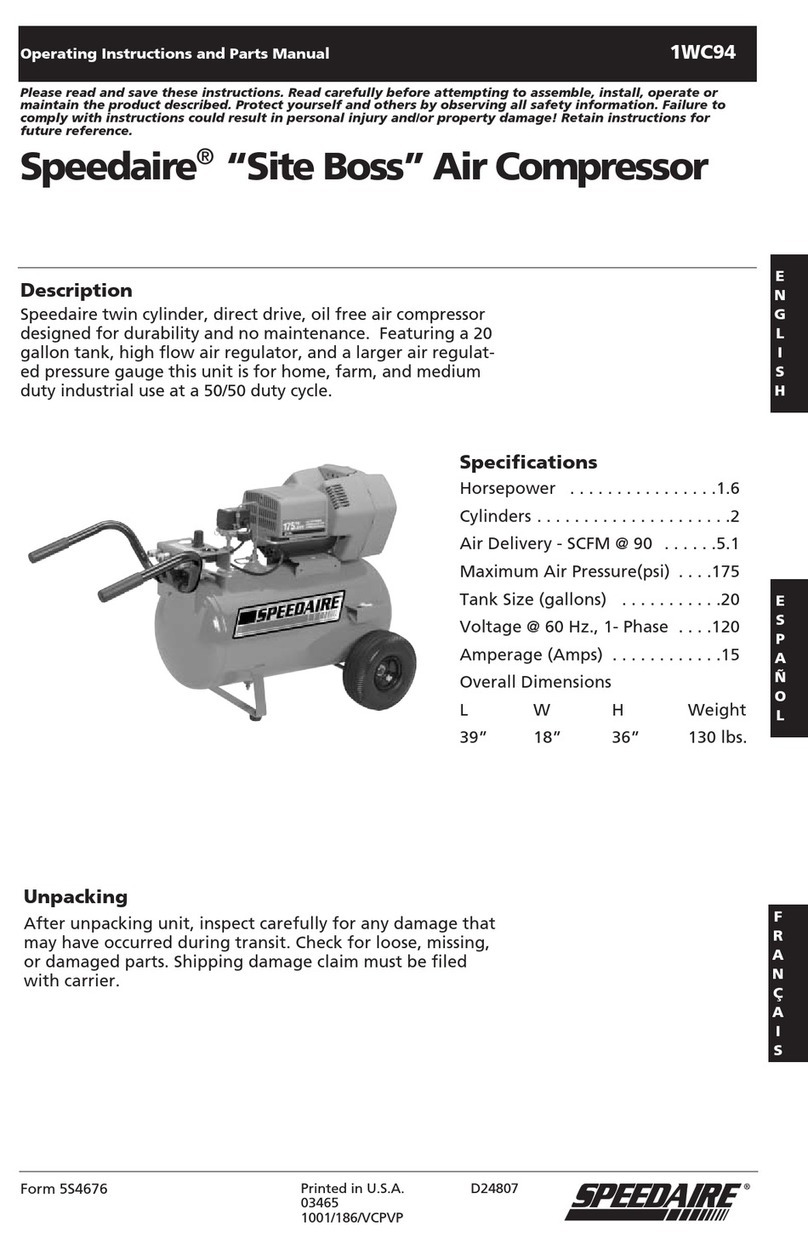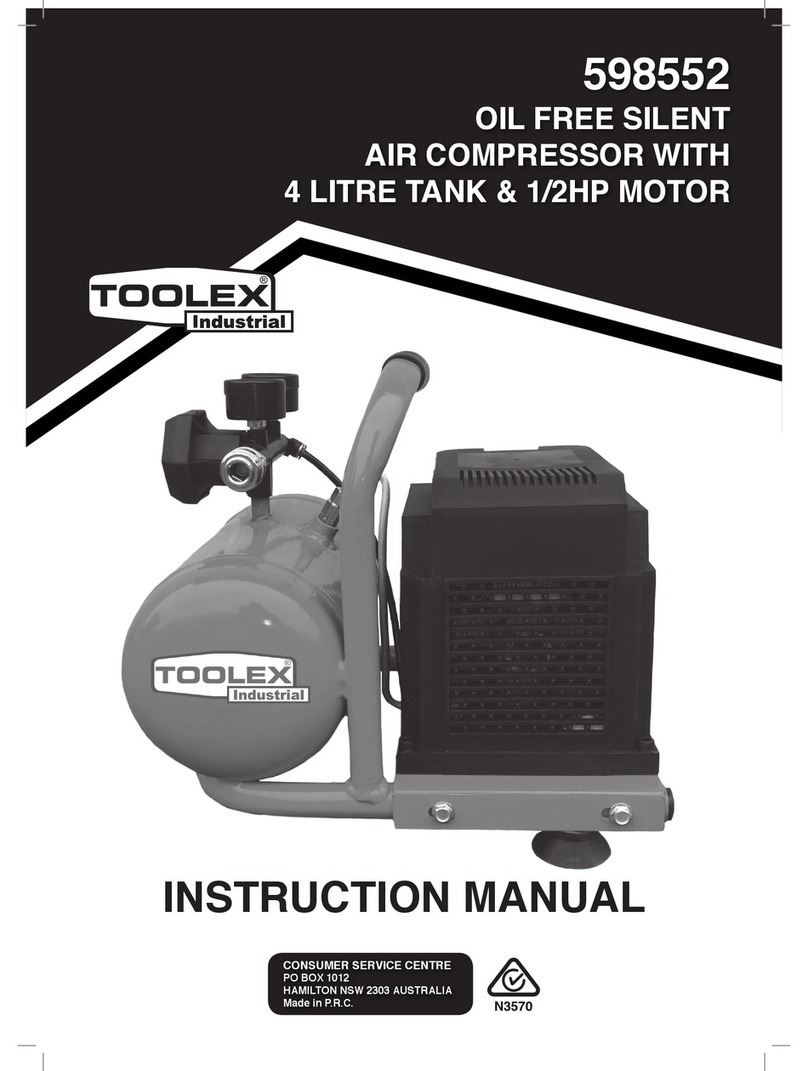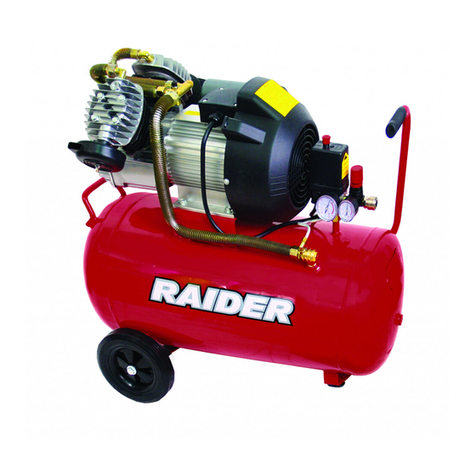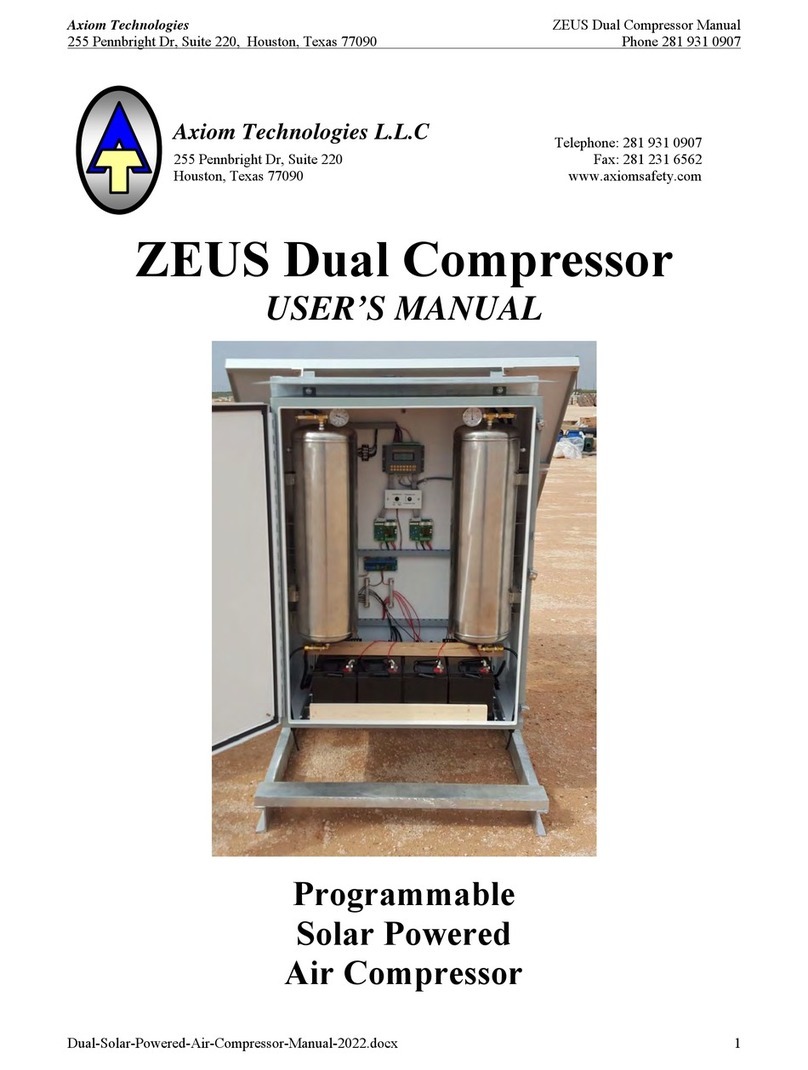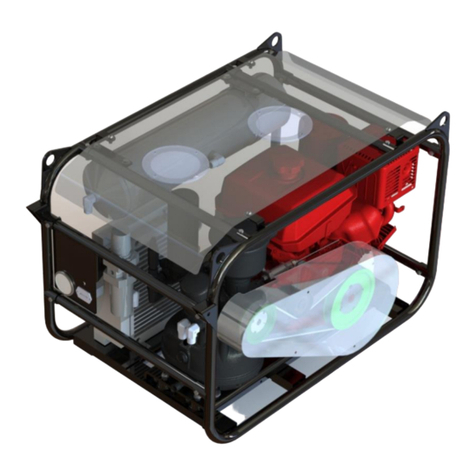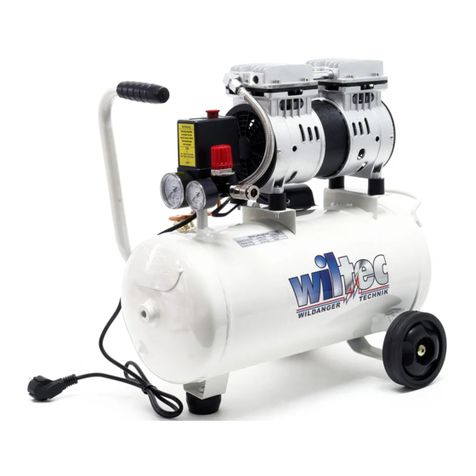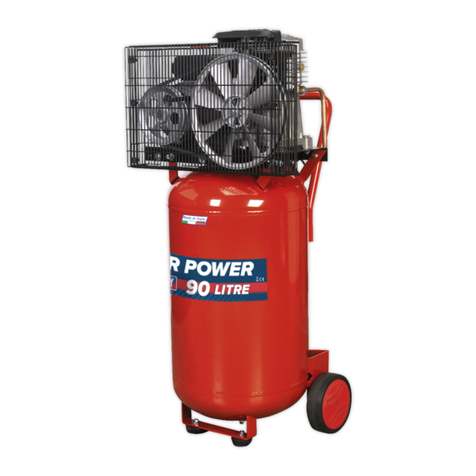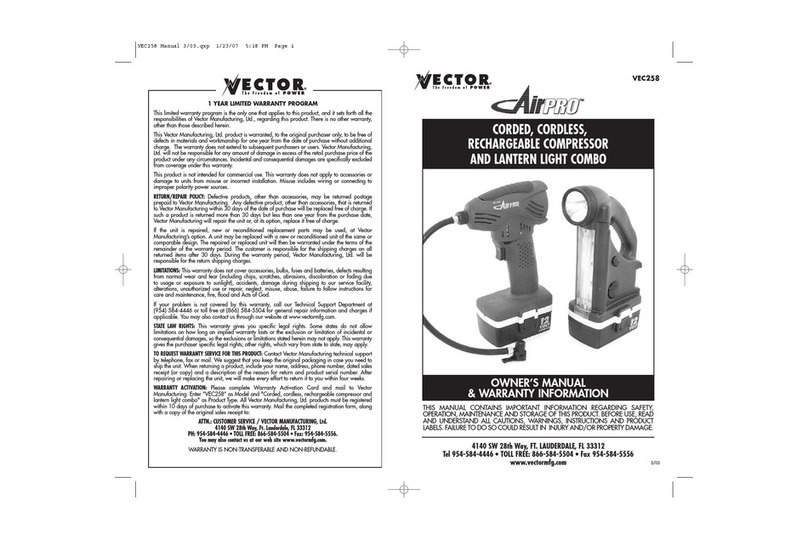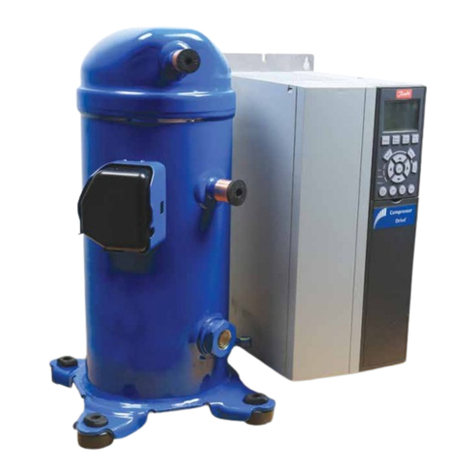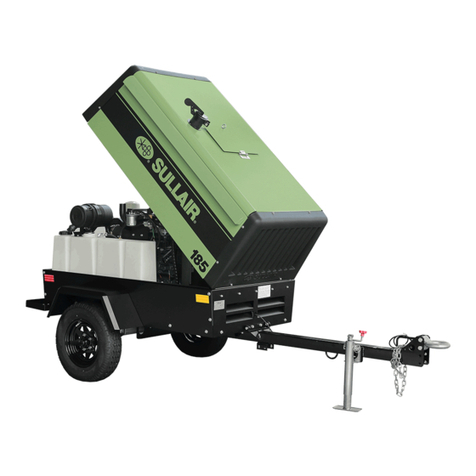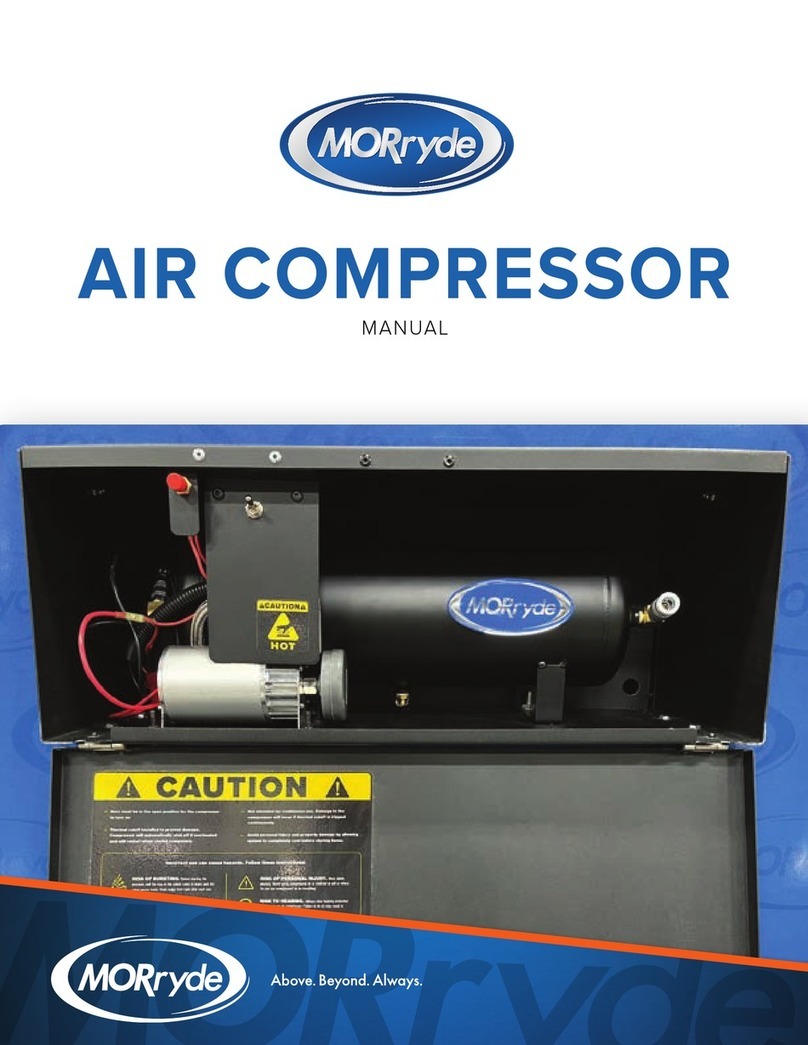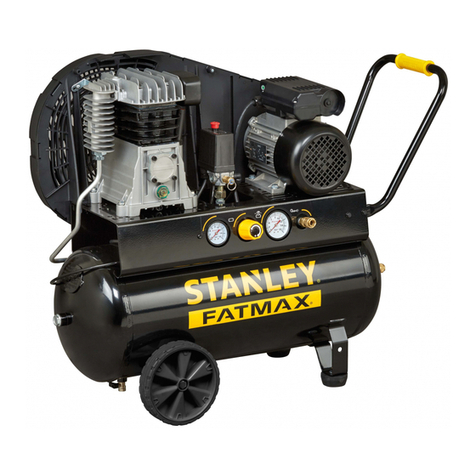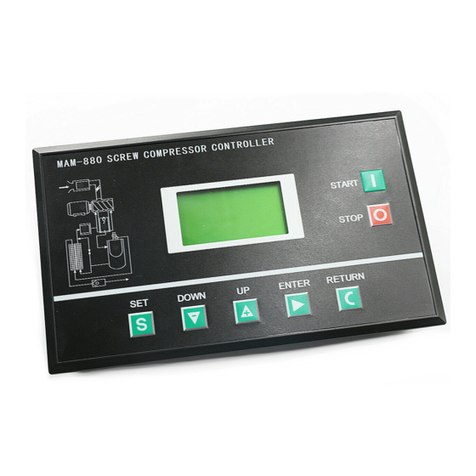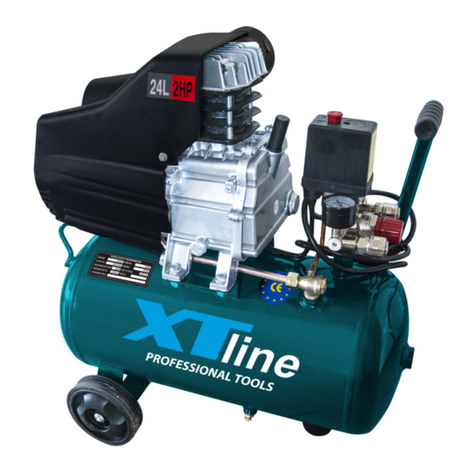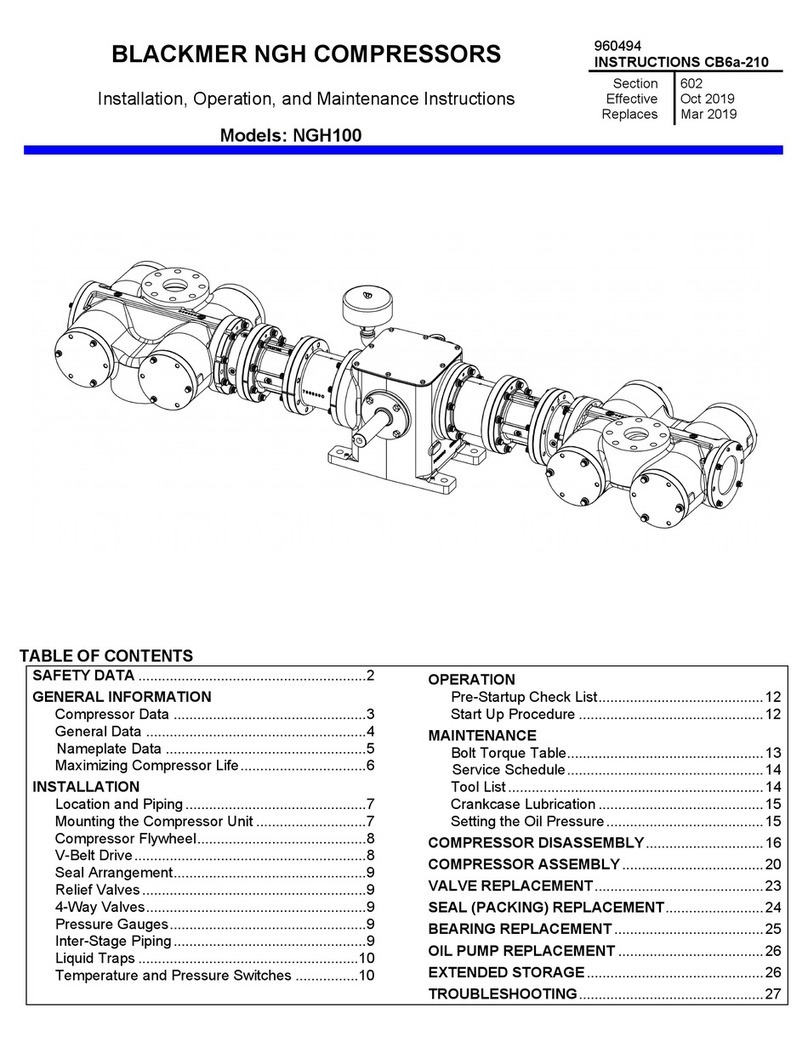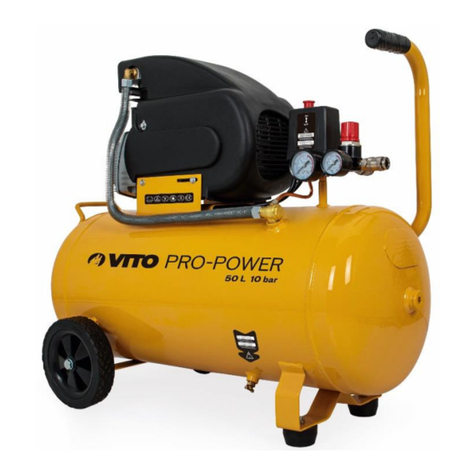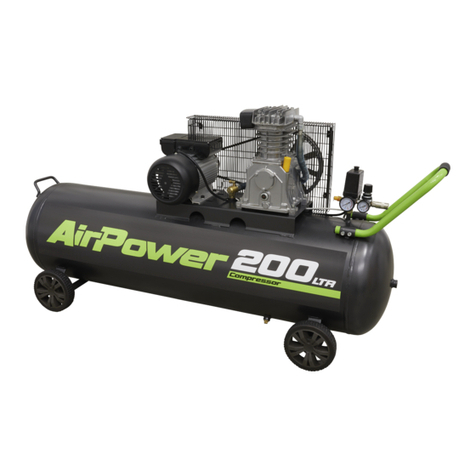Speedaire 48UY04 Instructions for use

Operating Instructions & Parts Manual EN
Portable Air
Compressor
Model 48UY04
IN572300AV 5/16

PLEASE READ AND SAVE
THESE INSTRUCTIONS.
READ CAREFULLY
BEFORE ATTEMPTING
TO ASSEMBLE, INSTALL,
OPERATE OR MAINTAIN THE
PRODUCT DESCRIBED.
PROTECT YOURSELF AND
OTHERS BY OBSERVING ALL
SAFETY INFORMATION. FAILURE
TO COMPLY WITH INSTRUCTIONS
COULD RESULT IN PERSONAL
INJURY AND/OR PROPERTY
DAMAGE! RETAIN INSTRUCTIONS
FOR FUTURE REFERENCE.
PLEASE REFER TO BACK COVER
FOR INFORMATION REGARDING
SPEEDAIRE’S WARRANTY AND
OTHER
IMPORTANT INFORMATION.
Model #: _________________
Serial #: _________________
Purch. Date: _____________
Printed in U.S.A.
02433 Version 00 5/2016
© 2013 W.W. Grainger, Inc.
All Rights Reserved

1
MAINTENANCE /
REPAIR
TROUBLESHOOTINGOPERATION
ASSEMBLY /
INSTALLATION
SAFETY /
SPECIFICATIONS
GETTING STARTED
BEFORE YOU BEGIN
Introduction
Air compressor units are intended to provide compressed air to power pneumatic tools, operate spray guns and
supply air for pneumatic valves and actuators. The pumps supplied with these units have oil lubricated bearings.
A small amount of oil carryover is present in the compressed air stream. Applications requiring air free of oil
vapor should have the appropriate filters installed. Any other use of these units will void the warranty and the
manufacturer will not be responsible for problems or damages resulting from such misuse.
QUICK REFERENCE
Required Oil (2 Options)
Single viscosity SAE30 ISO100 nondetergent compressor oil. Part number 4ZF21 or
1WG50.
10W30 synthetic oil such as Mobile 1 or 1WG49.
Oil Capacity
Approximately 8.5 oz. (Unit not shipped with oil)
UNPACKING
Do not lift or move unit without appropriately rated equipment. Be sure
the unit is securely attached to lifting device used. Do not lift unit by holding onto
tubes or coolers. Do not use unit to lift other attached equipment.
After unpacking the unit, inspect carefully for any damage that may have occurred during transit. Check for
loose, missing or damaged parts. Check to be sure all supplied accessories are enclosed with the unit. In case of
questions, damaged or missing parts, please call 1-855-504-5678 for customer assistance.
Do not operate unit if damaged during shipping, handling or use. Damage
may result in bursting and cause injury or property damage.

MAINTENANCE /
REPAIR TROUBLESHOOTING OPERATION
ASSEMBLY /
INSTALLATION GETTING STARTED
2
SAFETY /
SPECIFICATIONS
GENERAL SAFETY INSTRUCTIONS
Safety Guidelines
This manual contains information that is very important to know and understand. This information is provided for
SAFETY and to PREVENT EQUIPMENT PROBLEMS. To help recognize this information, observe the following
symbols.
Danger indicates an imminently hazardous situation which, if not avoided,
WILL result in death or serious injury.
Warning indicates a potentially hazardous situation which, if not avoided,
COULD result in death or serious injury.
Caution indicates a potentially hazardous situation which, if not avoided,
MAY result in minor or moderate injury.
Notice indicates important information, that if not followed, may cause
damage to equipment.
IMPORTANT: Information that requires special attention.
Safety Symbols
The following Safety Symbols appear throughout this manual to alert you to important safety hazards and
precautions.
California Proposition 65
This product or its power cord may contain chemicals known to the State
of California to cause cancer and birth defects or other reproductive harm. Wash
hands after handling.
You can create dust when you cut, sand, drill or grind materials such as wood,
paint, metal, concrete, cement, or other masonry. This dust often contains
chemicals known to cause cancer, birth defects, or other reproductive harm. Wear protective gear.
Important Safety Information
Please read and save these instructions. Read carefully before attempting to assemble, install,
operate or maintain the product described. Protect yourself and others by observing all safety
information. Failure to comply with instructions could result in personal injury and/or property
damage! Retain instructions for future reference.
This manual contains important safety, operational and maintenance information. If you have any questions, call
1-855-504-5678 for customer assistance.
Since the air compressor and other components (material pump, spray guns, filters, lubricators, hoses, etc.) used
make up a high pressure pumping system, the following safety precautions must be observed at all times:
Risk of
Moving
Parts
Risk of
Hot Parts
Risk of
Explosion
Risk of
Fumes
Risk of
Pressure
Risk of
Shock
MANUAL
Read
Manual
First
Risk of
Fire
Wear Eye
and Mask
Protection

MAINTENANCE /
REPAIR
TROUBLESHOOTINGOPERATION
ASSEMBLY /
INSTALLATION
GETTING STARTED
3
SAFETY /
SPECIFICATIONS
Important Safety Information (Continued)
BREATHABLE AIR WARNING
This compressor/pump is not equipped and should not be used “as is” to supply breathing quality
air. For any application of air for human consumption, the air compressor/pump will need to be
fitted with suitable in-line safety and alarm equipment. This additional equipment is necessary to
properly filter and purify the air to meet minimal specifications for Grade D breathing as described
in Compressed Gas Association Commodity Specification G 7.1, OSHA 29 CFR 1910. 134, and/or
Canadian Standards Associations (CSA).
DISCLAIMER OF WARRANTIES
In the event the compressor is used for the purpose of breathing air application and proper in-line
safety and alarm equipment is not simultaneously used, existing warranties shall be voided, and the
manufacturer disclaims any liability whatsoever for any loss, personal injury or damage.
General Safety
• Read all manuals included with this product carefully. Be thoroughly familiar with the controls and the proper
use of the equipment.
• Follow all local electrical and safety codes as well as the United States National Electrical Codes (NEC) and
Occupational Safety and Health Act (OSHA).
• Only persons well acquainted with these rules of safe operation should be allowed to use the compressor.
• Keep visitors away and NEVER allow children in the work area.
• Wear safety glasses and use hearing protection when operating the unit.
• Do not stand on or use the unit as a handhold.
• Before each use, inspect compressed air system and electrical components for signs of damage,
deterioration, weakness or leakage. Repair or replace defective items before using.
• Check all fasteners at frequent intervals for proper tightness.
Motors, electrical equipment and controls can cause electrical
arcs that will ignite a flammable gas or vapor. Never operate or repair in or near a
flammable gas or vapor. Never store flammable liquids or gases in the vicinity of the compressor.
Never operate compressor without a beltguard. This unit can
start automatically without warning. Personal injury or property damage could
occur from contact with moving parts.
• Do not wear loose clothing or jewelry that will get caught in the moving parts of the unit.
Compressor parts may be hot even if the unit is stopped.
• Keep fingers away from a running compressor; fast moving and hot parts will cause injury and/or burns.
• If the equipment should start to vibrate abnormally, STOP the engine/motor and check immediately for the
cause. Vibration is generally an indication of trouble.
• To reduce fire hazard, keep engine/motor exterior free of oil, solvent, or excessive grease.
An ASME code safety relief valve with a setting no higher than the Maximum
Allowable Working Pressure (MAWP) of the tank MUST be installed in the air lines
or in the tank for this compressor. The ASME safety valve must have sufficient flow and pressure
ratings to protect the pressurized components from bursting. The flow rating can be found in the parts
manual. The safety valve in the intercooler does not provide system protection.
Maximum operating pressure is 135 psi for single stage compressors. Do not
operate with pressure switch or pilot valves set higher than 135 psi (single stage).
• Never attempt to adjust ASME safety valve. Keep safety valve free from paint and other accumulations.
MANUAL

MAINTENANCE /
REPAIR TROUBLESHOOTING OPERATION
ASSEMBLY /
INSTALLATION GETTING STARTED
4
SAFETY /
SPECIFICATIONS
Important Safety Information (Continued)
Never attempt to repair or modify a tank! Welding, drilling or any other
modification will weaken the tank resulting in damage from rupture or explosion.
Always replace worn, cracked or damaged tanks.
Drain liquid from tank daily.
• Tanks rust from moisture build-up, which weakens the tank. Make sure to drain tank regularly and inspect
periodically for unsafe conditions such as rust formation and corrosion.
• Fast moving air will stir up dust and debris which may be harmful. Release air slowly when draining moisture
or depressurizing the compressor system.
Spraying Precautions
Do not spray flammable materials in vicinity of open flame or near
ignition sources including the compressor unit.
• Do not smoke when spraying paint, insecticides, or other flammable substances.
• Use a face mask/respirator when spraying and spray in a well ventilated area to prevent health and fire
hazards.
• Do not direct paint or other sprayed material at the compressor. Locate compressor as far away from the
spraying area as possible to minimize overspray accumulation on the compressor.
• When spraying or cleaning with solvents or toxic chemicals, follow the instructions provided by the chemical
manufacturer.
Save These Instructions
Do Not Discard
The DANGER, WARNING, CAUTION, and NOTICE notifications and instructions in this manual cannot
cover all possible conditions and situations that may occur. It must be understood by the operator that
caution is a factor which cannot be built into this product, but must be supplied by the operator.

MAINTENANCE /
REPAIR
TROUBLESHOOTINGOPERATION
ASSEMBLY /
INSTALLATION
GETTING STARTED
5
SAFETY /
SPECIFICATIONS
Figure 1 - Vertical Unit Identification
Getting To Know Your Compressor
Beltguard
Tank Pressure
Gauge
Compressor Pump
Air Filter (Not Shown)
Motor
Discharge Tube
Pressure Switch
Regulator
Manual Tank Drain

MAINTENANCE /
REPAIR TROUBLESHOOTING OPERATION
ASSEMBLY /
INSTALLATION GETTING STARTED
6
SAFETY /
SPECIFICATIONS
SPECIFICATIONS
DIMENSIONS
48UY04
Motor HP 2
Power 120V/240V
Phase 1 (single)
Displacement CFM 7.2
Air Delivery CFM @ 90 PSI 5.5
Air Delivery CFM @ 135 PSI 4.9
Max PSI 135
Pump RPM 1020
Tank Capacity 30 gallon
Unit Weight 178 lbs.
Amp Draw 15A / 7.5A
Max Duty Cycle 75%
Tank Outlet 1/4 NPT
48UY04
Length 23 in.
Width 24 in.
Height 46 in.

MAINTENANCE /
REPAIR
TROUBLESHOOTINGOPERATION
SAFETY /
SPECIFICATIONS
GETTING STARTED
7
ASSEMBLY /
INSTALLATION
INSTALLATION INSTRUCTIONS
GROUNDING
This product must be grounded. In the event of an electrical short circuit, grounding reduces the risk of electric
shock by providing an escape wire for the electric current. This product is equipped with a cord having a
grounding wire with an appropriate grounding plug. The plug must be plugged into an outlet that is properly
installed and grounded in accordance with all local codes and ordinances. Do not use grounding adapter.
Risk of electric shock. Improper use of grounding plug can result in a risk of
electrical shock. Plug must be plugged into an outlet that is properly installed and
grounded in accordance with local codes and ordinances by a qualified electrician.
This product comes from the factory ready for use on a nominal 120 volt circuit and has a grounding plug similar
to the plug illustrated in Figure 2. If the listed conditions cannot be met or if nuisance tripping of the current
protection device occurs, it may be possible to operate the compressor from a 120 volt 20 amp circuit. See Figure
2.
Check motor data plate for 240 volt compatibility. A 240 volt unit must be operated on a 240 volt circuit. The cord
must only plug into a 240 volt grounded outlet and may require a new cord and plug. See Figure 3. This product
may be modified to operate at 240V. To do so, a 240V power cord needs to be purchased and installed on the
unit and wired into the pressure switch just like the 120V cord. The panel on the back of the motor needs to be
opened and the flag terminals need to be moved so that the brown wire that is on terminal #1 is on terminal #7
and the white wire that is on terminal #3 needs to be moved to terminal #1 (where the brown wire was originally).
See Figure 4.
All wiring and electrical connections should be performed by a qualified
electrician. Installation must be in accordance with local codes and national
electrical codes. If not properly grounded, this tool can cause an electrical shock, particularly when
used in damp locations, in proximity of plumbing, outdoors.
Installation of grounding plug can result in electric shock. When repair or
replacement of the cord or plug is required, do not connect the grounding wire
to either flat blade terminal. The wire with insulation having an outer surface that is green with or
without yellow stripes is the grounding wire. Never connect green (or green and yellow) wire to a live
terminal.
Ground Pin
Grounded Outlet
Outlet - 120 V / 15 A
Outlet - 120 V / 20 A
Figure 2 - 120V
Grounded Outlet
Ground Pin
Outlet - 240 V
Figure 3 - 240V

MAINTENANCE /
REPAIR TROUBLESHOOTING OPERATION
SAFETY /
SPECIFICATIONS GETTING STARTED
8
ASSEMBLY /
INSTALLATION
INSTALLATION INSTRUCTIONS (CONTINUED)
Use only a 3-wire extension cord that has a 3-blade grounding plug and a 3-slot receptacle that accepts the plug
on the product. Make sure your extension cord is not damaged. When using an extension cord, be sure to use
one heavy enough to carry the current your product draws. For lengths less than 25 ft. 12-3 AWG extension
cords shall be used. An undersized cord results in a drop in the voltage and loss of power and overheating.
(NOTICE: Table below shows the correct size to use depending on cord length. When in doubt, use the next
heavier gauge. The smaller the gauge number, the heavier the cord.)
Use of an extension cord may cause excess heat to motor. This could lead to tripped breaker (at electrical panel)
or tripped thermal overload (on compressor motor). If this occurs, eliminate extension cord and plug compressor
directly into electrical outlet. Avoid using extension cords; use longer air hose(s) instead.
Check with a qualified electrician or serviceman when the grounding instructions are not completely understood,
or when in doubt as to whether the product is properly grounded. Do not modify the plug provided; if it does not fit
the outlet, have the proper outlet installed by a qualified electrician. Only connect the product to an outlet having
the same configuration as the plug. Do not use an adapter with this product.
Amp Rating
Range
Voltage Cord Length in Feet
120V 25 ft. 50 ft. 100 ft. 150 ft. 200 ft. 250 ft. 300 ft. 400 ft. 500 ft.
14-16 16 12 10 8 6 6 4 4 2
[Brown]
[Purple]
[Black]
[Yellow]
[White]
[Orange] Black
Cord
Lead
White
Cord
Lead
[Brown]
[Black]
Black
Cord
Lead
White
Cord
Lead
[Orange]
[White]
[Yellow]
[Purple]
120V Conguration 240V Conguration
Figure 4 - 120V and 240 Configuration

MAINTENANCE /
REPAIR
TROUBLESHOOTINGOPERATION
SAFETY /
SPECIFICATIONS
GETTING STARTED
9
ASSEMBLY /
INSTALLATION
INSTALLATION INSTRUCTIONS (CONTINUED)
Lubrication
Before operating compressor,
ensure oil is filled to the center of
the sight gauge (see figure 5).
Using any other type of oil may
shorten pump life and damage
valves.
Recommended Oil (2 Options)
Single viscosity SAE30 ISO100 nondetergent
compressor oil. Part number 4ZF21 or 1WG50.
10W30 synthetic oil such as Mobile 1 or 1WG49.
Oil Capacity
Approximately 8.5 oz.
Remove cap from oil fill opening. Install breather (found in
parts bag with this manual). Check oil level. See specification
label on compressor pump for the proper oil capacity and
oil type. All lubricated compressor pumps discharge some
condensed water and oil with the compressed air. Install
appropriate water/oil removal equipment and controls as
necessary for the intended application.
Do not use regular automotive oil. Additives in regular motor oil
can cause valve deposits and reduce pump life. For maximum
pump life, drain and replace oil after the first fifty (50) hours of
operation. Then perform oil changes every three (3) months.
Figure 5 - Lubrication
Oil Drain
Plug
Sight Gauge
Full
Low
Oil FIll
Area

MAINTENANCE /
REPAIR TROUBLESHOOTING OPERATION
SAFETY /
SPECIFICATIONS GETTING STARTED
10
ASSEMBLY /
INSTALLATION
OPERATING INSTRUCTIONS
All lubricated compressor pumps discharge some condensed water and oil with the compressed air. Install
appropriate water/oil removal equipment and controls as necessary for the intended application.
Failure to install appropriate water/oil removal equipment may result in damage to
machinery or workpiece.
Start-up /Break-in Procedure
Risk of Personal Injury. Do not attach air tools to open end of the hose until start-
up is completed and the unit checks okay.
Risk of Personal Injury. Never disconnect threaded joints with pressure in tank!
1. Check oil level per the Lubrication Section of this
manual.
2. Open the bottom tank drain valve (see Figure 6).
Turn outlet valve to open air flow.
3. Plug unit in.
4. Move pressure switch to the AUTO position to run
the unit (see Figure 7).
5. Run the unit for thirty (30) minutes at zero (0) psi
(under no load) to break in pump parts.
6. Move the pressure switch lever or knob to OFF
and turn tank drain valve to shut off air flow. The
compressor is now ready for use.
7. Change oil after first fifty (50) hours of operation.
Then perform oil changes every three (3) months
or two hundred (200) hours of run time, whichever
comes first.
Compressor Use
It is extremely important to operate the compressor in
a clean, well-ventilated area where the surrounding
air temperature will not be more than 100°F. Do not
locate the compressor air inlet near steam, paint spray,
sandblast areas or any other source of contamination.
Figure 6
Figure 7

MAINTENANCE /
REPAIR
TROUBLESHOOTINGOPERATION
SAFETY /
SPECIFICATIONS
GETTING STARTED
11
ASSEMBLY /
INSTALLATION
OPERATING INSTRUCTIONS (CONTINUED)
On/Off Cycling of Compressor
Risk of Bursting. Drain tank every day to prevent corrosion and possible injury due
to tank damage. Do not operate drain with more than 40 psi in tank or drain valve
may be damaged. Drain tank of moisture daily using the drain valve in the bottom of the tank.
Unit care and maintenance. Drain liquid from tank daily.
In the AUTO position, the compressor pumps air into
the tank. When a shut-off (preset “cut-out”) pressure is
reached, the compressor automatically shuts off.
If the compressor is left in the AUTO position and air
is depleted from the tank by use of a tire chuck, tool,
etc., the compressor will restart automatically at its
preset “cut-in” pressure. When a tool is being used
continuously, the compressor will cycle on and off
automatically.
In the OFF position, the compressor will not operate.
Drain Tank. Disconnect, tag, unplug and lock out power
source; release pressure. Drain moisture from tank by
opening drain valve underneath tank (See Figure 8).
MOISTURE IN COMPRESSED AIR
Moisture in compressed air will form into droplets as it comes from an air compressor pump.
When humidity is high or when a compressor is in continuous use for an extended period of
time, this moisture will collect in the tank. When using a paint spray or sandblast gun, this
water will be carried from the tank through the hose, and out of the gun as droplets mixed
with the spray material.
IMPORTANT: This condensation will cause water spots in a paint job, especially when
spraying other than water based paints. If sandblasting, it will cause the sand to cake and
clog the gun, rendering it ineffective. A filter in the air line, located as near to the gun as
possible, will help eliminate this moisture.
Figure 8

TROUBLESHOOTING GUIDE
MAINTENANCE /
REPAIR TROUBLESHOOTING OPERATION
ASSEMBLY /
INSTALLATION
SAFETY /
SPECIFICATIONS GETTING STARTED
12
OPERATION
SYMPTOM POSSIBLE CAUSE(S) CORRECTIVE ACTION
Low discharge pressure 1. Air demand exceeds pump capacity 1. Reduce air demand or use a compressor with more
capacity.
2. Restricted air intake 2. Clean or replace the air filter element.
3. Air leaks (fittings, tubing on compressor,
or plumbing outside of system)
3. Listen for escaping air. Apply soap solution to all
fittings and connections. Bubbles will appear at points
of leakage. Tighten or replace leaking fittings or
connections. Use pipe thread sealant.
4. Blown gaskets 4. Replace any gaskets proven faulty on inspection.
5. Leaking or damaged valves 5. Remove head and inspect for valve breakage,
misaligned valves, damaged valve seats, etc. Replace
defective parts and reassemble.
Unit care and maintenance.
Install a new head gasket
each time the head is removed.
Excessive noise (knocking) 1. Loose motor pulley or flywheel 1. Tighten pulley/flywheel clamp bolts and set-screws.
2. Loose fasteners on pump or motor 2. Tighten fasteners.
3. Lack of oil in crankcase 3. Check for proper oil level; if low, check for possible
damage to bearings. Dirty oil can cause excessive
wear.
4. Worn connecting rod 4. Replace connecting rod. Maintain oil level and change
oil more frequently.
5. Worn piston pin bores 5. Remove piston assemblies from the compressor and
inspect for excess wear. Replace excessively worn
piston pin or pistons, as required. Maintain oil level and
change oil more frequently.
6. Piston hitting the valve plate 6. Remove the compressor head and valve plate and
inspect for carbon deposits or other foreign matter on
top of piston. Replace head and valve plate using new
gasket. See Lubrication section for recommended oil.
7. Noisy check valve in compressor
system
7. Replace check valve.
Risk of Explosion. Do not
disassemble check valve
with air pressure in tank.
Large quantity of oil in the
discharge air
NOTE: In an oil-lubed
compressor there will always be
a small amount of oil in the air
stream.
1. Worn piston rings 1. Replace with new rings. Maintain oil level and change
oil more frequently.
2. Compressor air intake restricted 2. Clean or replace filter. Check for other restrictions in
the intake system.
3. Excessive oil in compressor 3. Drain down to full level.
4. Wrong oil viscosity 4. Use Mobil 1®10W-30 or full synthetic.
Water in discharge air/tank Normal operation. The amount of water
increases with humid weather
1. Drain tank more often. At least daily.
2. Add a filter to reduce the amount of water in the air
line.
Motor hums and runs slowly or
not at all
1. Low voltage 1. Check incoming voltage. It should be approximately
230 volts. Motor will not run properly on 208 volts. Low
voltage could be due to wires (from electrical source
to compressor) being too small in diameter and / or
too long. Have a qualified electrician check these
conditions and make repairs as needed.
2. Use of extension cord 2. Do not use an extension cord. Use longer air hose with
larger diameter.
3. Too many devices on same circuit 3. Limit the circuit to the use of compressor only
4. Loose electrical connections 4. Check all electrical connections.
5. Malfunctioning pressure switch -
contacts will not close
5. Replace pressure switch.
6. Malfunctioning check valve 6. Replace check valve.
Risk of Explosion. Do not
disassemble check valve
with air pressure in tank.

TROUBLESHOOTING GUIDE (CONTINUED)
MAINTENANCE /
REPAIR
TROUBLESHOOTINGOPERATION
ASSEMBLY /
INSTALLATION
SAFETY /
SPECIFICATIONS
GETTING STARTED
13
SYMPTOM POSSIBLE CAUSE(S) CORRECTIVE ACTION
Motor hums and runs slowly or
not at all (Continued) 7. Defective unloader valve on pressure
switch
7. Replace unloader valve.
8. Defective motor capacitor(s) 8. Replace capacitor(s).
9. Defective motor 9. Replace motor.
Reset mechanism cuts out
repeatedly or circuit breaker trips
repeatedly
1. Lack of proper
ventilation/room temperature too high
1. Move compressor to well-ventilated area.
2. Too many devices on same circuit 2. Limit the circuit to the use of only the air compressor.
3. Restricted air intake 3. Clean or replace filter element.
4. Loose electrical connection 4. Check all electrical connections.
5. Pressure switch shut-off pressure set
too high
5. Replace pressure switch.
6. Malfunctioning check valve 6. Replace check valve.
Risk of Explosion. Do not
disassemble check valve
with air pressure in tank.
7. Defective unloader valve on pressure
switch
7. Replace unloader valve.
8. Defective motor capacitor(s) 8.Replace capacitor(s).
9. Malfunctioning motor 9. Replace motor.
Tank does not hold pressure
when compressor is off and the
shut off valve is closed
1. Air leaks (fittings, tubing on compressor,
or plumbing outside system)
1. Check all connections with soap and water solution.
Tighten; or remove and apply sealant to threads, then
reassemble.
2. Worn check valve 2. Replace check valve.
Risk of Explosion. Do not
disassemble check valve
with air pressure in tank.
3. Check tank for cracks or pin holes 3. Replace tank. Never repair a damaged tank.
Pressure switch continuously
blows air out the unloader valve
Malfunctioning check valve Replace the check valve if the unloader valve on the
pressure switch bleeds off constantly when unit shuts off.
Risk of Explosion. Do not
disassemble check valve
with air pressure in tank.
Excessive vibration 1. Loose fasteners on pump or motor 1. Tighten fasteners.
2. Belt needs replaced 2. Replace with correct size.
3. Belt alignment 3. Align flywheel and pulley.
Pressure switch does not
release air when the unit shuts
off
Malfunctioning unloader valve on pressure
switch
Replace the unloader valve if it does not release the
pressure for a short period of time when the unit shuts off.
Risk of Explosion. Do not
disassemble unloader
valve with air pressure in tank.

TROUBLESHOOTING OPERATION
ASSEMBLY /
INSTALLATION
SAFETY /
SPECIFICATIONS GETTING STARTED
14
MAINTENANCE /
REPAIR
MAINTENANCE AND INSPECTION INSTRUCTIONS
Disconnect, tag and lock out power source then release all pressure
from the system before attempting to install, service, relocate or perform any
maintenance.
In order to maintain efficient operation of the compressor system, check the air filter and oil level before each
use. The ASME safety valve should also be checked daily (see Figure 9). Pull ring on safety valve and allow the
ring to snap back to normal position. This valve automatically releases air if the tank pressure exceeds the preset
maximum. If air leaks after the ring has been released, or the valve is stuck and cannot be actuated by the ring,
the ASME safety valve must be replaced.
Do not tamper with the ASME safety valve.
Tank
Never attempt to repair or modify a tank! Welding, drilling or any other
modification will weaken the tank resulting in damage from rupture or explosion.
Always replace worn, cracked or damaged tanks.
Drain liquid from tank daily.
The tank should be carefully inspected at a minimum of once a year. Look for cracks forming near the welds. If a
crack is detected, remove pressure from tank immediately and replace.
Compressor Lubrication
See Installation. Add oil as required. The oil should be changed every three months or after every 200 hours of
operation; whichever comes first.
If the compressor is run under humid conditions for short periods of time, the humidity will condense in the
crankcase and cause the oil to look creamy. Oil contaminated by condensed water will not provide adequate
lubrication and must be changed immediately. Using contaminated oil will damage bearings, pistons, cylinders
and rings and is not covered under warranty. To avoid water condensation in the oil, periodically run the
compressor with tank pressure near 120 psi for single stage compressors by opening the drain cock or an air
valve connected to the tank or hose. Run the pump for an hour at a time at least once a week or more often if the
condensation reoccurs.
IMPORTANT: Change oil after first 50 hours of operation.
Air Filter
Never run the compressor pump without an intake air filter or with
a clogged intake air filter. The air filter element should be checked
monthly (see Figure 10). Operating compressor with a dirty filter can
cause high oil consumption and increase oil contamination in the
discharge air. If the air filter is dirty it must be replaced.
Components
Turn off all power and clean the cylinder head, motor, fan blades, air lines, aftercooler and tank on a monthly
basis.
Figure 9 - ASME Safety Valve
Figure 10 - Air Filter Element

TROUBLESHOOTINGOPERATION
ASSEMBLY /
INSTALLATION
SAFETY /
SPECIFICATIONS
GETTING STARTED
15
MAINTENANCE /
REPAIR
MAINTENANCE AND INSPECTION INSTRUCTIONS (CONTINUED)
Belts
Lock out and tag the power then release all pressure from the tank to prevent
unexpected movement of the unit.
Check belt tension every 3 months. Adjust belt tension to allow 3/8 inch to 1/2 inch deflection with normal thumb
pressure. Also, align belts using a straight edge against the face of the flywheel and touching the rim on both
sides of the face. The belts should be parallel to this straight edge (see Figure 11). Dimension A should be the
same as B and C to ensure proper alignment of the belts.
Slots in the bed-plate allow for sliding the motor back and forth to adjust belt tension.
Removing Belt Guard
When removing belt guard front to
inspect or replace belts, inspect plastic
retaining clips and replace if damaged or if clip can be
removed without a tool.
Removing Retaining Clips
1. Using crescent wrench on pliers, rotate clip 90°.
2. Pull clip out and away from beltguard.
3. Reverse process to reinstall after inspecting the clip.
Storage
If compressor is to be stored for a short period of time, make sure
that it is stored in a normal position and in a cool protected area.
A B
C
Figure 11 - Top View
Air Compressor
Motor
Flywheel
Straight Edge
Motor Drive
Pulley
Setscrew
Maintenance Schedule
OPERATION DAILY MONTHLY 3 MONTHS
Check Safety Valve l
Drain Tank (see Figure 6) l
Check Oil Level l
Clean or Change Air Filter l
Check Intercooler l
Clean Unit Components l
Check Belt Tightness l
Change Oil (see Figure 5) l
Figure 12
1
2

For Repair Parts, call 1-800-Grainger
24 hours a day – 365 days a year
Please provide following information:
-Model number
-Serial number (if any)
-Part description and number as shown in parts list
MAINTENANCE /
REPAIR TROUBLESHOOTING OPERATION
ASSEMBLY /
INSTALLATION
SAFETY /
SPECIFICATIONS GETTING STARTED
16
REPAIR PARTS ILLUSTRATION FOR 48UY04
53425
26
20 35
15
17
28
36 21
29
47
19
31
16
20
42 43
10
11
23
11 22
7
51
50
46
40
8
7
44
12
45
13
48
7
38
39
37
14
1
49
6
9
2
30
32 33
27
41
2
24
48
48

MAINTENANCE /
REPAIR
TROUBLESHOOTINGOPERATION
ASSEMBLY /
INSTALLATION
SAFETY /
SPECIFICATIONS
GETTING STARTED
17
REPAIR PARTS LIST FOR 48UY04
Ref.
No. Description Part
Number Qty
1TANK, 30 GALLONS AR067500CG 1
2SPINLOCK NUT, 5/16"-18 ST146001AV 6
3PNUEMATIC WHEEL, 10" WA006000AV 2
4AXLE BOLT, 3/8"-16 X 3" ST084700AV 2
5FLANGE NUT, 3/8"-16 ST033500AV 2
6MOTOR, 2HP 120/240V MC019800SJ 1
7COMPRESSOR PUMP 2WGX6 1
8SELF TAPPING SCREW,
5/16"-12 ST016500AV 4
9HEX HEAD BOLT, 5/16"-18 X
3/4" ST016000AV 4
10 RUBBER FERRULE, 1/2"
TUBE ST085200AV 1
11 COMPRESSION NUT, 1/2" ST033001AV 2
12 MOTOR PULLEY PU015200AV 1
13 BELT, AX48 BT020401AV 1
14 SELF TAPPING SCREW,
#5-5/8"
ST073277AV,
n4
15 REDUCING BUSHING, 1/2" X
1/4" NPT ST071428AV 1
16 REDUCING BUSHING, 1/4" X
1/8" NPT ST071407AV 1
17 PIPE NIPPLE, 1/4" NPT ST016800AV 1
18 HEX PIPE NIPPLE, 1/4" NPT HF002401AV 1
19 ASME SAFETY VALVE,
175PSI V-215109AV 1
20 PRESSURE GAUGE, 300PSI GA016306AV 2
21 HANDLE HL705600AV 2
22 COMPRESSION FITTING ST159001AV 1
23 EXHAUST TUBE , 1/2" VT035801AP 1
24 BRASS FERRULE, 1/2" TUBE ST032900AV 1
25 POWER CORD, 120V EC012601AV 1
26 PRESSURE SWITCH CORD
GRIP CW209500AV 1
27 STRAIN RELIEF SCREW ST209800AV 1
28 HEX HEAD SELF TAPPIN
SCREW. #8 X 3/8" ST074407AV 2
29 HANDLE BOLT, 1/4"-20 X 1.25" PM001901AV 4
30 HANDLE NUT, 1/4"-20 PM031101AV 4
30 GAUGE s1
Ref.
No. Description Part
Number Qty
31 MOTOR POWER CORD EC012800AV 1
32 DRAINCOCK, 1/4" D-1403 1
33 RUBBER FOOT ST162602AV 2
34 PRESSURE SWITCH CW209000AV 1
35 REGULATOR RE206202AV 1
36 GRIP - 2
37 BELT GUARD BACK BG313200AV,
n1
38 BELT GUARD FRONT BG313300AV,
n1
39 PLASTIC RETAINING CLIP ST199700AV,
n4
40 BELT GUARD BRACKET BG220400AV 1
41 WASHER, 5/16" ST011200AV,
n4
42 QUICK CONNECT FITTING,
1/4" TUBE X 1/8" NPT - 1
43 CHECK VALVE CV221503SJ 1
44 MOTOR KEY KE000900AV 1
45 SET SCREW, 1/4"-20 X 1/2" ST012200AV 1
46 SELF TAPPING SCREW, #10-
3/8" ST073278AV 1
47 PTFE TUBE, 1/4" X 13" ST117802AV 1
48 PUMP FLYWHEEL 4B253 1
49 AIR FILTER HOUSING VH901700AV 1
50 AIR FILTER ELEMENTS VH901800AV 1
51 CRANK CASE BREATHER VH901100AV 1
Repair Parts Kits
nBELT GUARD KIT VT551953AV

For Repair Parts, call 1-800-Grainger
24 hours a day – 365 days a year
Please provide following information:
-Model number
-Serial number (if any)
-Part description and number as shown in parts list
REPAIR PARTS ILLUSTRATION FOR 2WGX6
MAINTENANCE /
REPAIR TROUBLESHOOTING OPERATION
ASSEMBLY /
INSTALLATION
SAFETY /
SPECIFICATIONS GETTING STARTED
18
6
4
9
3
1
10
13
7
12
15
11
16
14
2
5
8
17
18
19
20
8
Table of contents
Languages:
Other Speedaire Air Compressor manuals
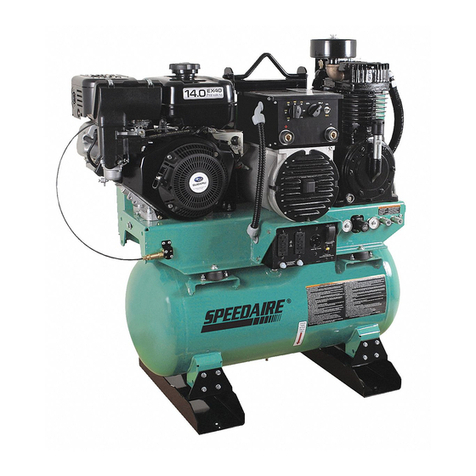
Speedaire
Speedaire 15D802 User manual

Speedaire
Speedaire 1WD36 Instructions for use
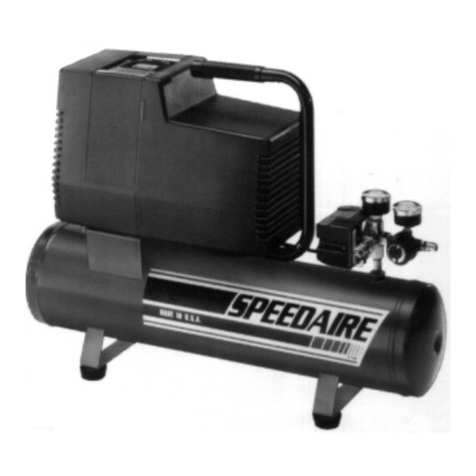
Speedaire
Speedaire 5Z598C Service manual
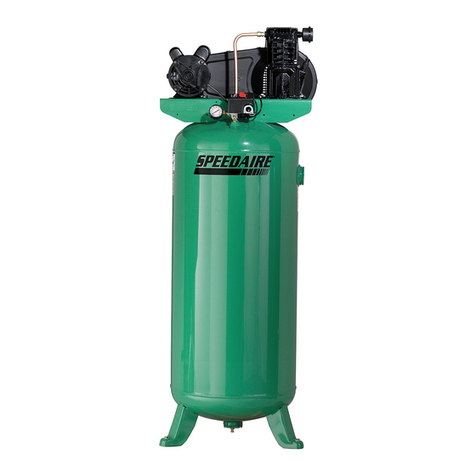
Speedaire
Speedaire Cast Iron Series User manual
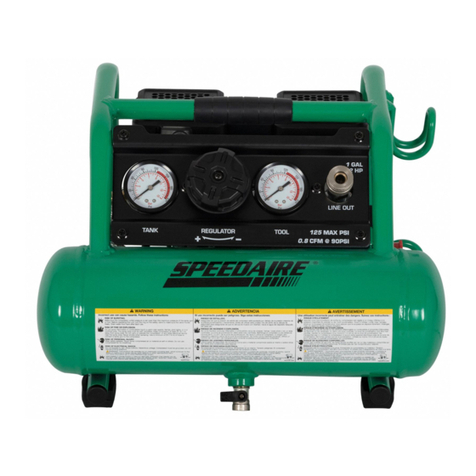
Speedaire
Speedaire 787U76 Instructions for use

Speedaire
Speedaire 1WC95 Service manual

Speedaire
Speedaire 4UP73 Instructions for use
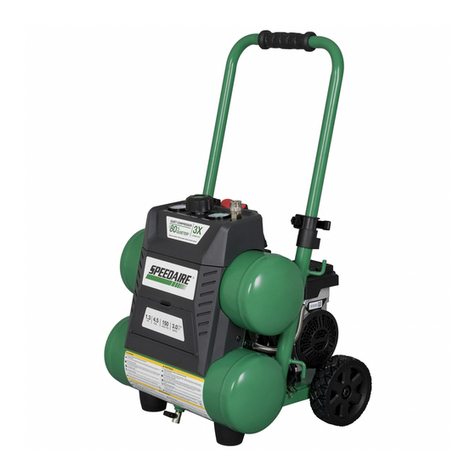
Speedaire
Speedaire 787U78 Instructions for use
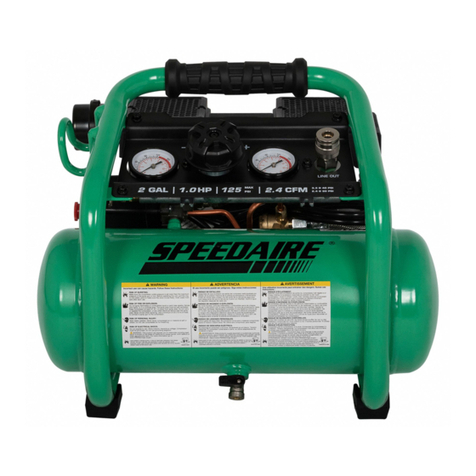
Speedaire
Speedaire 787U77 Instructions for use
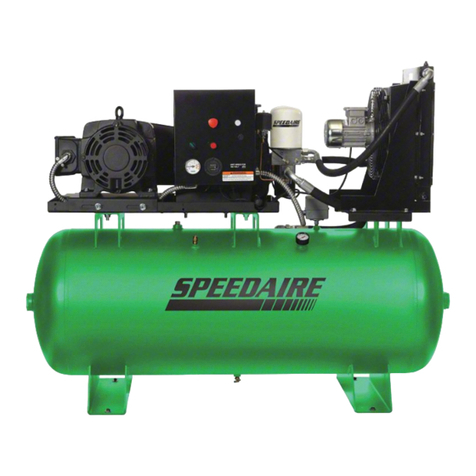
Speedaire
Speedaire 40HU29 User manual
